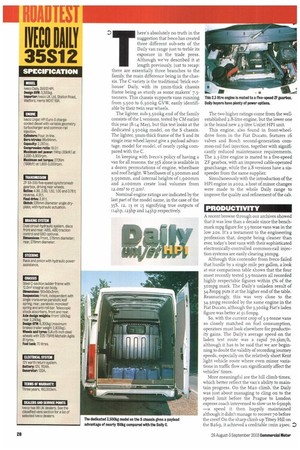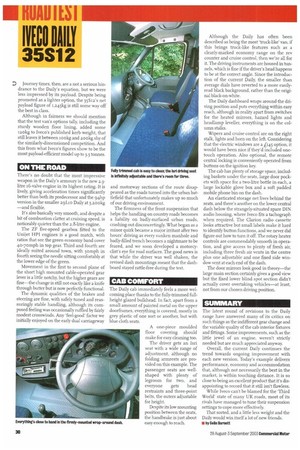here's absolutely no truth in the suggestion that Iveco has
Page 28

Page 30

If you've noticed an error in this article please click here to report it so we can fix it.
created three different sub-sets of the Daily van range just to treble its exposure in the trade press. Although we've described it at length previously, just to recap: there are essentially three branches to the family, the main difference being in the chassis. The C variety is the traditional 'brick outhouse' Daily, with its 5mm-thick chassis frame being as sturdy as some makers' 7.5tonners. This chassis supports vans running from 3,500 to 6,500kg GVW, easily identifiable by their twin rear wheels.
The lighter, sub-3,500kg end of the family consists of the L versions, tested by CM earlier this year (8-14 May), but this test looks at the dedicated 3,500kg model, on the S chassis. The lighter, 3mm-thick frame of the S and its single rear wheel layout give a payload advantage, model for model, of nearly i5okg compared with the C.
In keeping with Iveco's policy of having a van for all reasons, the 355 alone is available in a dozen permutations of engine, wheelbase and roof height. Wheelbases of 3,30onun and 3,95omm, and internal heights of 1,9 o omm and 2,100mm create load volumes from 12.om3 to 17.2m3.
Nominal engine ratings are indicated by the last part of the model name, in the case of the 355, 12, 13 or 15 signifying true outputs of rt4hp, 12,3hp and 143hp respectively.
The two higher ratings come from the wellestablished 2.8-litre engine, but the lower one is the brand new 2.3-litre Unijet HPI unit.
This engine, also found in front-wheeldrive form in the Fiat Ducato, features 16 valves and Bosch second-generation common-rail fuel injection, together with significantly reduced maintenance requirements. The 2.3-litre engine is mated to a five-speed ZF gearbox, with an improved cable-operated gearchange, while the 2.8 versions have a sixspeeder from the same supplier.
Simultaneously with the introduction of the HPI engine in 2002, a host of minor changes were made to the whole Daily range to improve the quality and refinement of the cab.
PRODUCTIVITY
A recent browse through our archives showed that it was less than a decade since the benchmark mpg figure for 3.5-tonne vans was in the low 20s. It's a testament to the engineering profession that, despite being cleaner than ever, today's best vans with their sophisticated electronically-controlled common-rail injection systems are easily clearing 3ompg.
Although this contender from Iveco failed that hurdle by a single mile per gallon, a look at our comparison table shows that the four most recently tested 3.5-tonners all recorded highly respectable figures within 5% of the 3ompg mark. The Daily's unladen result of 34.8mpg puts it at the higher end of the table. Reassuringly, this was very close to the 34.mpg recorded by the same engine in the Fiat Ducato, although the 3,300kg Fiat's laden figure was better at 31.6mpg.
So, with the current crop of 3.5-tonne vans so closely matched on fuel consumption, operators must look elsewhere for productivity gains. The Daily's average speed on the laden test route was a rapid 70.3Icm/h, although it has to be said that we are beginning to doubt the validity of recording journey speeds, especially on the relatively short Kent light vehicle route where even minor variations in traffic flow can significantly affect the vehides' times.
More meaningful are the hill climb times, which better reflect the van's ability to maintain progress. On the M2o climb, the Daily was just about managing to cling on to the speed limit before the Prague to London express coach intervened to slow us to 65mph —a speed it then happily maintained although it didn't manage to recover 70 before the crest! On the sharp climb up Titsey Hill on the B269, it achieved a creditable imin 23sec.
Journey times, then, are a not a serious hindrance to the Daily's equation, but we were less impressed by its payload. Despite being promoted as a lighter option, the 35Si z's net payload figure of 1,245kg is still some way off the best in class.
Although in fairness we should mention that the test van's options tally, including the sturdy wooden floor lining, added some 120kg to Iveco's published kerb weight, that still leaves it between iookg and 200kg shy of the similarly-dimensioned competition. And this from what Iveco's figures show to be the most payload-efficient model up to 3.5 tonnes.
ON THE ROAD
There's no doubt that the most impressive weapon in the Daily's armoury is the new 2.3litre i6-valve engine in its highest rating. It is lively, giving acceleration times significantly better than both its predecessor and the 94hp version in the smaller 29 Li o Daily at 3,20 okg —and flexible.
It's also basically very smooth, and despite a bit of combustion clatter at cruising speed, is noticeably quieter than the 2.8-litre engine.
The ZF five-speed gearbox fitted to the Unijet HPI engines is a good match, with ratios that see the green economy band cover 40-70mph in top gear. Third and fourth are ideally suited around town, with 3omph in fourth seeing the needle sitting comfortably at the lower edge of the green.
Movement in the first to second plane of the short high mounted cable-operated gear lever is a little notchy, but the higher gears are fine—the change is still not exactly like a knife through butter but is now perfectly functional.
The dynamic qualities of the brakes and steering are fine, with safely tuned and reassuringly stable handling, although its composed feeling was occasionally ruffled by fairly modest crosswinds. Any `feel-good' factor we initially enjoyed on the early dual carriageway and motorway sections of the route disappeared as the roads turned into the urban battlefield that unfortunately makes up so much of our driving environment.
The firmness of the front suspension that helps the handling on country roads becomes a liability on badly-surfaced urban roads, crashing out disconcertingly. What began as a minor quirk became a major irritant after two hours' driving as every sunken manhole and badly-filled trench becomes a nightmare to be feared, and we soon developed a motorcyclist's eye for road surfaces. The good news is that while the driver was well shaken, the revised dash mountings meant that the dashboard stayed rattle-free during the test.
CAB COMFORT
The Daily cab immediately feels a more welcoming place thanks to the fully-trimmed fullheight glazed bulkhead. In fact, apart from a small amount of painted metal on the upper doorframes, everything is covered, mostly in grey plastic of one sort or another, but with blue cloth seats.
A one-piece moulded floor covering should make for easy cleaning too.
The driver gets an Isri seat with a wide range of adjustment, although no folding armrests are provided on this example. The passenger seats are wellshaped with plenty of legroom for two, and everyone gets head restraints and three-point belts, the outers adjustable for height.
Despite its low mounting position between the seats, the handbrake is just about easy enough to reach. Although the Daily has often been described as being the most 'truck-like' van, if this brings truck-like features such as a clearly-marked economy range on the rev counter and cruise control, then we're all for it. The driving instruments are housed in tunnels, which is fine if the driver's head happens to be at the correct angle. Since the introduction of the current Daily, the smaller than average dials have reverted to a more easilyread black background, rather than the original black-on-white.
The Daily dashboard wraps around the driving position and puts everything within easy reach, although in reality apart from switches for the heated mirrors, hazard lights and headlamp leveller, everything is on the column stalks.
Wipers and cruise control are on the right stalk, lights and horn on the left. Considering that the electric windows are a £145 option, it would have been nice if they'd included onetouch operation. Also optional, the remote central locking is conveniently operated from buttons on the ignition key.
The cab has plenty of storage space, including baskets under the seats, large door pockets with space for a two-litre bottle in each, a large lockable glove box and a soft padded mobile phone bin on the dash.
An elasticated storage net lives behind the seats, and there's another on the lower central dash below the strangely-situated spare DIN audio housing, where Iveco fits a tachograph when required. The Clarion radio cassette looks attractive but small labels make it hard to identify button functions, and we never did figure out how to turn it off. The rotary heater controls are commendably smooth in operation, and give access to plenty of fresh air, including three fresh air vents in the centre plus one adjustable and one fixed side window vent at each end of the dash.
The door mirrors look good in theory—the large main section certainly gives a good view but the fixed lower blind spot section didn't actually cover overtaking vehicles—at least, not from our chosen driving position.
SUMMARY
The latest round of revisions to the Daily range have answered many of its critics on such things as the indifferent gear change and the variable quality of the cab interior fixtures and fittings. Some improvements, such as the little jewel of an engine, weren't strictly needed but are much appreciated anyway.
Overall, the current Daily continues the trend towards ongoing improvement with each new version. Today's example delivers performance, economy and accommodation that, although not necessarily the best in the market, is within touching distance. It is so close to being an excellent product that it's disappointing to record that it still isn't flawless.
While Iveco can't be blamed for the 'Third World' state of many UK roads, most of its rivals have managed to tune their suspension settings to cope more effectively.
That sorted, and a little less weight and the Daily would win itself a lot of new friends.
• by Coil Barnett




































































































































































